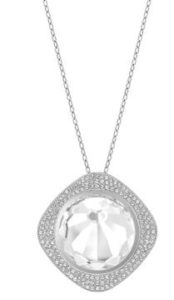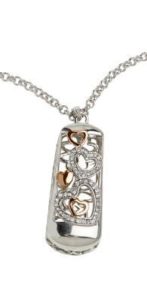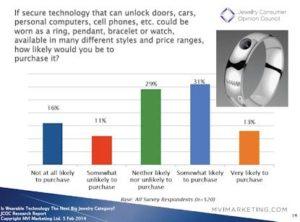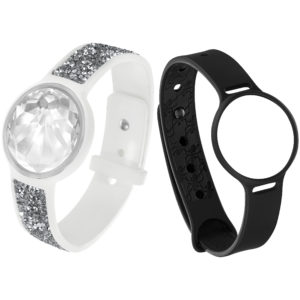Vegas Buzz for Wearable Tech
Wearable technology was the word on everyone’s lips at the JCK show in Las Vegas last month. Leaders in bringing creative jewelry design to market in this category, Richline and Swarovski showed new product in the Plumb Club and organized a panel discussion with leading technology companies that had everyone buzzing over the possibilities.
 An advocate of joining tech developers with jewelry designers and manufacturers, Swarovski sees wearable technology as the most exciting new thing brewing in the industry. “For 2016, we see the emergence of wearable tech as a major innovation and influence, with a functional link to health and entertainment,” says Cheryl Jester, trend and communications manager for Swarovski in New York. “Wired magazine anticipates that wearable technology will be as big as the smart phone. What makes this mega-trend interesting for us, are signs showing that alongside technological advances, a new aesthetic approach is turning these gadgets into jewels and fashion accessories.”
An advocate of joining tech developers with jewelry designers and manufacturers, Swarovski sees wearable technology as the most exciting new thing brewing in the industry. “For 2016, we see the emergence of wearable tech as a major innovation and influence, with a functional link to health and entertainment,” says Cheryl Jester, trend and communications manager for Swarovski in New York. “Wired magazine anticipates that wearable technology will be as big as the smart phone. What makes this mega-trend interesting for us, are signs showing that alongside technological advances, a new aesthetic approach is turning these gadgets into jewels and fashion accessories.”
Launched earlier this year, Swarovski’s wearable Shine line, featuring the Activity Tracking Crystal, debuted in Vegas. Designed in collaboration with Misfit Wearables, this nine-accessory collection includes interchangeable bracelets, watchbands and pendants designed with Swarovski crystals. Available in white and violet face, the large, faceted centerpiece crystal counts steps, measures calories burned, and tracks sleep patterns when used with Swarovski’s smart phone app. Later this year, they’ll launch a solar powered version. “Our Swarovski Activity Tracking Jewelry collection incorporates our strong jewelry styling point of view, developing versatile pieces that can work with this very practical device, which speaks to the modern, multifaceted woman,” says Jester.
At JCK this year Richline unveiled its smart jewelry designs and partnerships hinted at since announci ng distribution deals with Omate and Cuff earlier this year. The manufacturer showcased new products featuring differentiated technology from companies including Say and MightyCast, as well as an assortment of “compatibles” that offer more stylish, luxury alternatives for use with existing wearable products like Fitbit and Jawbone.
ng distribution deals with Omate and Cuff earlier this year. The manufacturer showcased new products featuring differentiated technology from companies including Say and MightyCast, as well as an assortment of “compatibles” that offer more stylish, luxury alternatives for use with existing wearable products like Fitbit and Jawbone.
“Function meets Fashion: We felt it was essential to balance entirely new innovations as well as elegant options for existing products,” explains Mark Hanna, Richline CMO in New York. “On the one hand, there are several popular fitness wearables that we can help make more stylish. On the other, recent advances in technology have made it possible for us to create jewelry, for the elegant lifestyle, that can do far more than fitness.”
Richline introduced two tiers of product offerings: Fine jewelry that primarily consists of designs made with precious metals, and fashion jewelry that offers more affordable designs made with bronze and base metals. In addition to fitness tracking, many of Richline‘s designs offer features centered on personalization, notification, and discrete security. The designs, says Hanna, bring a combination of style and tech to an untapped audience of fashion‐forward jewelry shoppers. “We feel like we’re just getting started,” adds Ramona Genao‐Archibald, EVP of Merchandising. “Our team is dedicated to finding the best emerging technologies and new ways to make them look better than ever before.”
“Living in Digital Times” editor, Robin Raskin, who moderated the wearable tech panel discussion, as part of the JCK Talks educational series, hails this “a historic moment” for both the tech and jewelry worlds. “Shop better, live better, stay connected, and look good doing it!” More manufacturers are embracing technology and expanding in this niche, she says, noting that if the jewelry industry doesn’t do it, someone else will. “Jewelry has already lost a lot of consumer spending to Apple and Best Buy, this is your opportunity to gain the business back. Why give up this category to other retailers to sell?”
 There are opportunities to design around existing technology and also design technology around existing jewelry design. The technology is growing beyond sports and fitness to healthcare where providers seek to monitor everything from heart rate to blood sugar. Biology is the next hardware revolution, Raskin cites.
There are opportunities to design around existing technology and also design technology around existing jewelry design. The technology is growing beyond sports and fitness to healthcare where providers seek to monitor everything from heart rate to blood sugar. Biology is the next hardware revolution, Raskin cites.
“Wearable technology is the most exciting thing to happen in the jewelry industry in long time,” hails Martin Hurwitz, CEO of MVI Marketing, San Luis Obispo, California, who notes that in order for it to be successful for jewelers it must be fashionable, not techy. “Retailers are clamoring for product they can sell. There’s a slight disconnect in what the industry wants and what’s available right now. Richline and Swarovski have done a lot of research in this category and are taking the lead in bringing product to jewelers.” Retailers who want to be successful with wearable tech must have a web presence and omni-channel marketing, he says to reach the consumers interested in this category who will be researching product online.
According to research conducted by MVI through its Jewelry Consumer Opinion Council (JCOC) in February 2014, 72% of respondents have already heard of wearable technology; and 30% at the time were already looking at smart watches. Research also indicated that 44% were likely to purchase jewelry with secure technology that could unlock doors, cars, personal computers, cell phones, etc.; and 55% said they’d like this type of secure technology added to jewelry they already own. More than half said they were interested in an earring that would work with their smart phone as a listening device and microphone.
“Retailers who do their research can better decide which direction to go in,” says Hurwitz, who notes that many of these tech companies are looking for early adopters to test market their products. MVI has a detailed list of products available and at what stages of developmental they are in.










